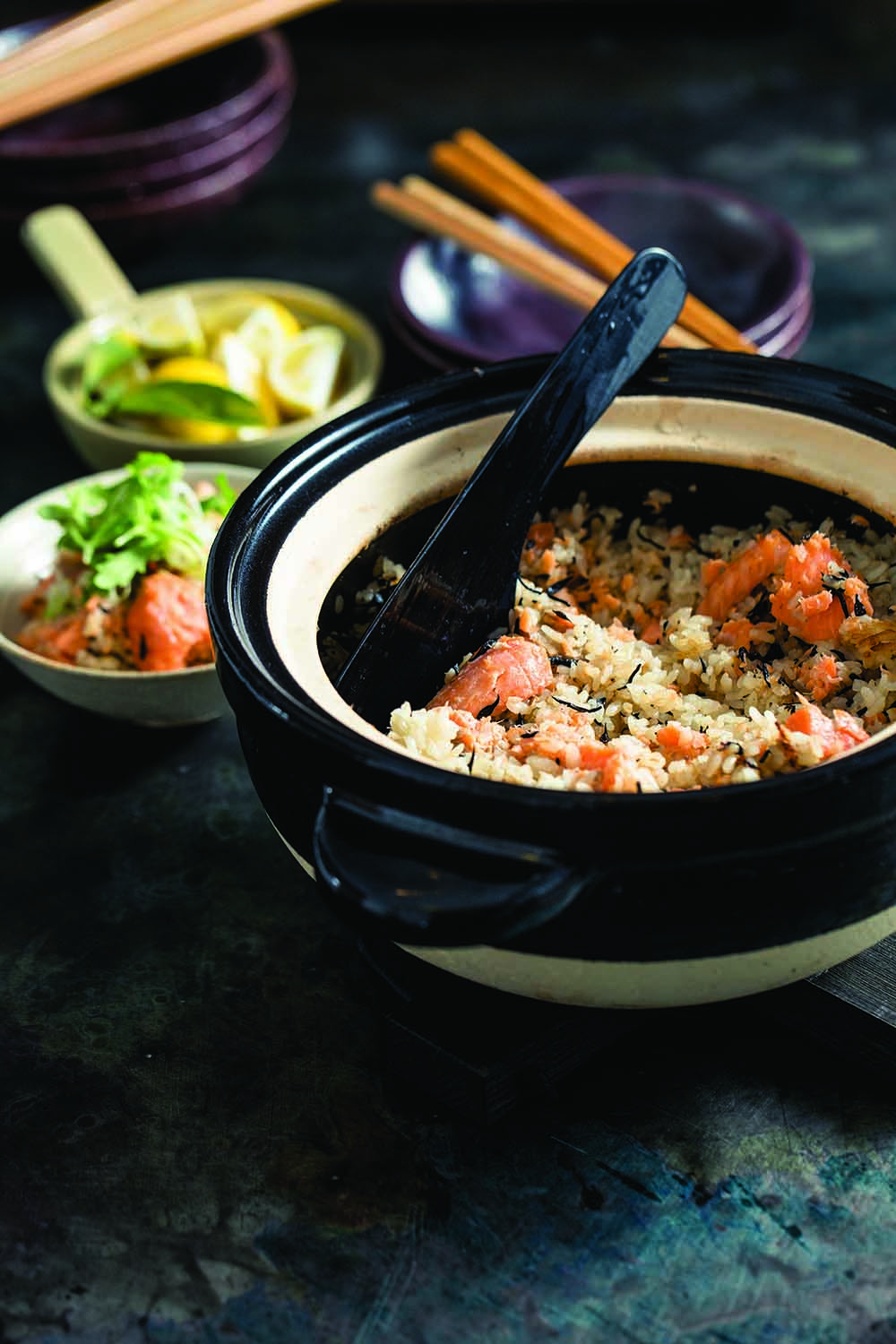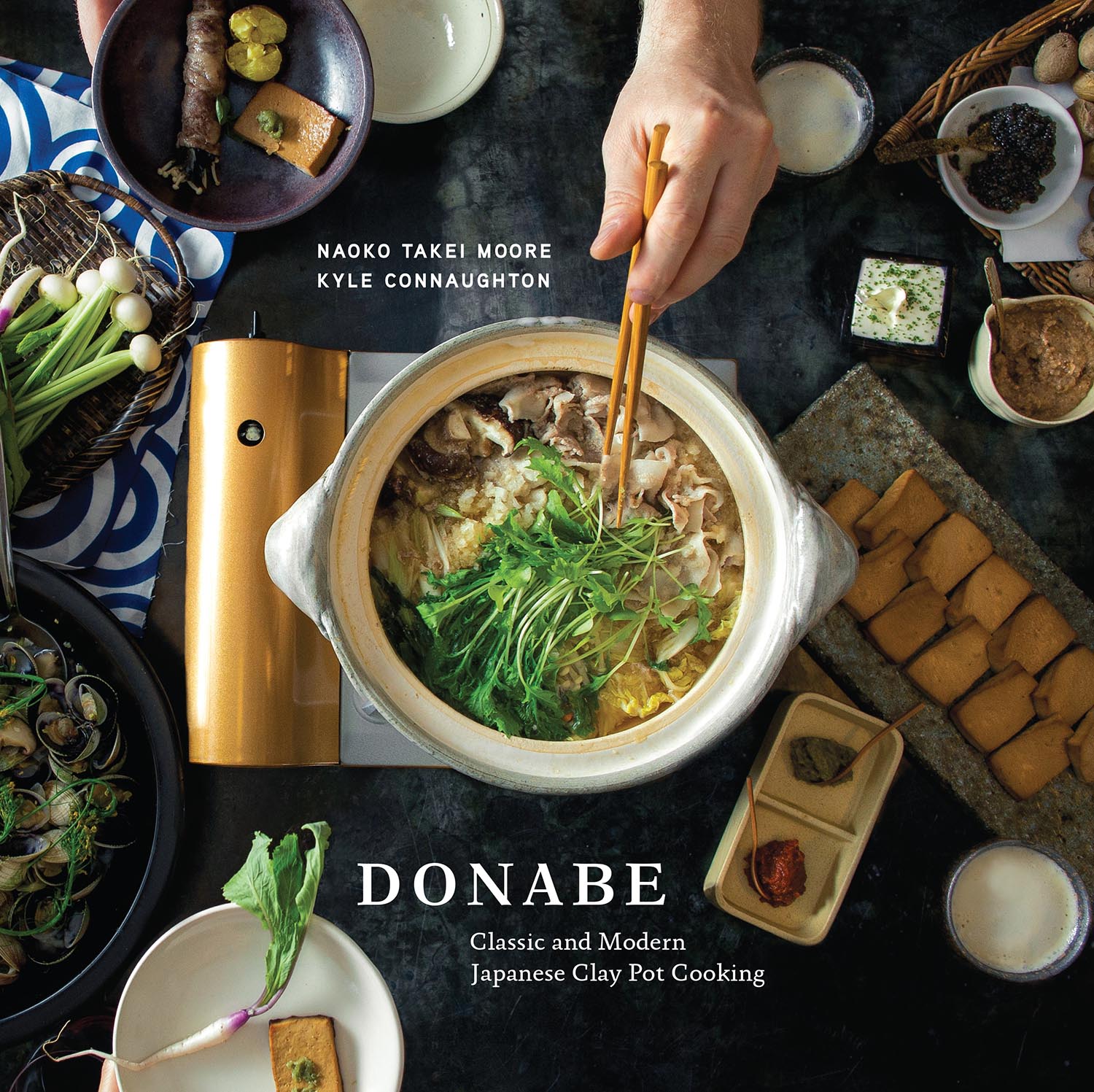Recipe for Salmon and Hijiki Rice, by Naoko Takei Moore
A simple dish that's full of character thanks to the presence of brown seaweed: this is the most popular recipe from the chef's cookery courses.

Reprinted with permission from Donabe: Traditional and Modern Japanese Clay Pot Cooking by NAOKO TAKEI MOORE AND KYLE CONNAUGHTON Photography by Eric Wolfinger. Copyright 2015. Published by Ten Speed Press, an imprint of Penguin Random House.
Before getting started on this recipe, the favourite of Naoko Takei Moore and taken from her book Donabe – Classic and Modern Japanese Clay Pot Cooking, cowritten with chef Kyle Connaughton, you need to be confident that you have the time. Once the ingredients are ready, they simply need to be placed in the donabe, a clay pot commonly used in Japanese cooking, but the preparation for this salmon and hijiki rice starts the night before the meal, with the salting of the fish.
To add character to the dish, the Japanese chef, who describes herself as ‘Mrs Donabe’ on her website, decided to add hijiki, brown seaweed in the shape of noodles, that are used to make various dishes like soups and salads, or as a condiment.
Serves 4 to 6
Ingredients
450 ml short-grain white rice, rinsed
400 ml kombu and bonito dashi (see separate recipe)
2 tablespoons sake
2 teaspoons usukuchi shoyu (light-coloured soy sauce)
2 teaspoons grilled sesame oil
3 g (about 1 tablespoon) dried hijiki seaweed, rehydrated (see note below)
200 g salt-cured salmon (recipe to follow), cut into 2 to 3 pieces, or store-bought lightly salted salmon (shio-jake)
Mixed chopped herbs and aromatics (such as a handful of daikon sprouts; 1 green onion, white and green parts; and 1 small bunch mitsuba), tossed with a seeded and thinly sliced dried red chili or 1/2 teaspoon red pepper flakes, for serving
Lemon wedges, for serving
Equipment:
1 double-lidded donabe rice cooker (600 ml capacity)
Method
To make Japanese-style grilled salmon, slice the cured fillet into four to six pieces and cook over a stove-top grill or pan-fry until done. You can also roast the whole fillet in the oven for eight to ten minutes at 230°C and serve family-style. Serve with grated daikon and lemon wedges as condiments, if you like.
Rub the salt all over both sides of the fillet and wrap with two layers of plastic wrap.
Place the salmon on a tray and place another flat-bottomed tray on top of the fish. Place something that weighs 900 g to 1.25 kg on the top tray. Refrigerate for at least 24 hours and up to 48 hours.
Remove the plastic wrap and wipe off the moisture and salt from the salmon with paper towels. Your cured salmon is ready to cook.
In the donabe, combine the rice with the dashi, sake, usukuchi shoyu, and sesame oil. Let the rice soak for 20 minutes.
Spread the rehydrated hijiki over the rice and lay the salmon on top. Cover with both lids and cook over medium-high heat for 13 to 15 minutes. Turn off the heat and let it rest undisturbed for 20 minutes.
Uncover, peel off the salmon skin (also remove the bones if using store-bought salted salmon), and gently fluff by breaking up the fish with a spatula until all the components are mixed thoroughly. Serve in individual bowls at the table. Top with some mixed chopped herbs, and add a squeeze of lemon.
Note: Here are the simple ways to rehydrate dried hijiki. First, soak the hijiki in an ample amount of water in a bowl for about 30 minutes. Make sure you don’t oversoak the hijiki, as it contains rich water-soluble fibre that could be lost, and the texture will become too mushy. Gently transfer the hijiki by hand into a colander, trying to leave most of the gritty stuff behind. Finally, rinse thoroughly under running water and drain well.
Donabe – Classic and Modern Japanese Clay Pot Cooking (2015) by Naoko Takei Moore and Kyle Connaughton, is published by Ten Speed Press and is currently only available in English.
In their book, chefs Naoko Takei Moore and Kyle Connaughton present traditional Japanese recipes made using a donabe as well as their more modern versions, sometimes inspired by California, where they both live. Donabe – Classic and Modern Japanese Clay Pot Cooking also provides information, in the introduction, about the origin, history, and functioning of this traditional Japanese pot. As a complement to their own recipes, the pair also share those from renowned chefs who use a donabe in the kitchens at their restaurants, like David Kinch, Namae Shinobu, and Nick Balla.
Originally from Japan, Naoko Takei Moore has lived in Los Angeles since 2001. A graduate of the Le Cordon Bleu programme at the California School of Culinary Arts, she also holds a Wine Expert certificate from the Japan Sommelier Association. She runs TOIRO, a physical shop located in Los Angeles and also found online, where she sells donabe, all made by hand in the Iga region of Japan, and selected with care. A TOIRO shop selling donabe but also offering cookery courses opened in 2017 in Los Angeles.
Kyle Connaughton began his career in Los Angeles, working as an apprentice in one of the oldest Japanese restaurants in the city. After working in Japan alongside chef Michel Bras, among others, he returned to California where he now runs Single Thread Farms, a three-Michelin-starred restaurant.

Reprinted with permission from Donabe: Traditional and Modern Japanese Clay Pot Cooking by NAOKO TAKEI MOORE AND KYLE CONNAUGHTON Photography by Eric Wolfinger. Copyright 2015. Published by Ten Speed Press, an imprint of Penguin Random House.
TRENDING
-
The Tattoos that Marked the Criminals of the Edo Period
Traditional tattoos were strong signifiers; murderers had head tattoos, while theft might result in an arm tattoo.

-
Paris, Tokyo: Robert Compagnon
With his co-chef and talented wife, Jessica Yang, Robert Compagnon opened one of the top new restaurants in Paris: Le Rigmarole.
 3:31
3:31 -
Chiharu Shiota, Red Threads of the Soul
Last year, more than 660,000 people visited the retrospective 'Chiharu Shiota: The Soul Trembles' exhibit at the Mori Art Museum.

-
‘Before Doubting Others, Doubt Yourself. Who Can Truly Say a Dish Isn’t What It Used to Be?’
In ‘A Non-Conformist’s Guide to Surviving Society’, author Satoshi Ogawa shares his strategies for navigating everyday life.

-
The Story of Sada Yacco, the Geisha who Bewitched Europe
Described by Dazed magazine as the first beauty influencer, she has been restored to her former glory since 2019.





